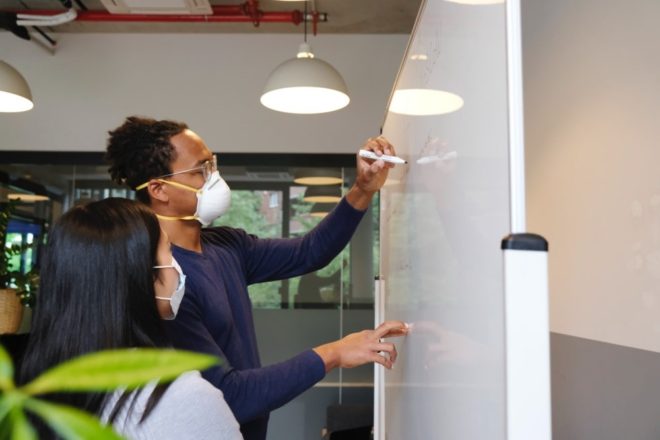Business owners must make tough decisions about when, and how, to bring employees back to work amid the COVID-19 pandemic. While business owners may want to reopen to stay viable, their workers are anxious about returning. Workers have legitimate concerns about their health and safety, which can lead to increased levels of anxiety in an already troubled time.
Highly stressed workers can be costly for businesses. However, the right preparations and interventions can help business leaders support their workers’ wellbeing while also protecting their bottom lines. The WorkforceMHQ tool can help businesses assess how workers are adjusting to their “new normal,” find places for intervention, and evaluate if their health and safety protocols are improving employee wellbeing.
Concerns about Returning
In anticipation of employees returning to in-person work, 59% of workers report that they are not confident that their new offices will keep their health and safety in mind. Trust between workers and employers is crucial for businesses to operate smoothly. These new statistics show that there are already signs of trouble on this front.
In addition to unsafe environments, workers are concerned that they will be exposed to the coronavirus because of customers, clients, and others who are not taking the pandemic seriously. This sentiment is especially strong in certain sectors:
- 71% in education are afraid of virus exposure
- 73% in entertainment are afraid of virus exposure
- 75% in retail are afraid of virus exposure
Making matters more challenging, some workers cannot enforce safety guidelines when customers violate the rules. Several companies in the USA have stopped workers from enforcing face mask and other safety rules because of concerns about “physical confrontations.” The concerns about violence are valid, but with no other enforcement plans in place, workers and their loved ones are at higher risk for infection.
Finally, some workers are afraid to speak up about their concerns because they are worried about backlash from employers, or because they feel that their concerns won’t be taken seriously. In this situation employees are worried that if they do not show up to work due to these concerns, they could be labeled as “non-compliant” and possibly even lose their jobs.
The Mental Health Quotient at Work
Business leaders know that a stressed and anxious workforce can have enormous economic consequences. When employees are struggling with their mental health, businesses face lower productivity, higher turnover rates, and higher healthcare costs. However, when companies have data about worker wellbeing to assess their safety protocols, they may be able to reduce the risks of doing business during COVID-19.
The WorkforceMHQ is a confidential online tool that assesses different dimensions of employee wellbeing, including Mood and Outlook, Social Self, Drive and Motivation and Mind Body Connection, and provides employers with insights and recommendations for strategies and policies that could improve employee wellbeing. It includes aggregated wellbeing scores across the organization as a whole as well as across different segments of the workforce, for example for different departments, locations or demographics. Individual workers also receive their own personal MHQ score, explanation of their score by dimension, and recommendations about next steps.
These scores and insights allow business leaders to establish a baseline for how their workers are doing as they return to work in-person. The scores can show employers many different insights, such as:
- Parents returning to work have poorer Mood and Outlook scores than those without children because of difficulties with work-life balance.
- East Coast employees score higher on Drive and Motivation than workers in the West Coast location because of differences with managerial support.
- The HR department has the best wellbeing scores of any department in the company, and this is related to the presence of supportive working relationships between colleagues.
Business leaders can then use these scores to choose interventions that will meet the needs of their workers. In the examples above, a company may decide to follow up with those who are struggling with their work-life balance and put in extra measures to support them returning to work. Alternatively, leaders may investigate the day-to-day management of the East Coast office and use lessons learned to support West Coast workers.
Results from the WorkforceMHQ can also show which aspects of the businesses’ COVID-19 safety protocols are increasing worker wellbeing and which ones are not. This allows businesses to validate that their policies are supporting workers’ safety and wellbeing, and identify any policies that need to be improved over time. Since the tool is confidential, it also provides a way for workers to give feedback on the policies without worrying about retaliation.
Finally, the WorkforceMHQ provides a way for businesses to evaluate if their efforts are succeeding. If business owners see wellbeing scores rising over time, they can be more confident that their safety strategies are working.
See here for more information about using the WorkforceMHQ for your business.

